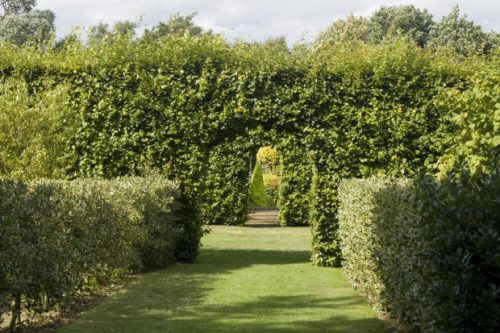The answer to the question “When should homeowners trim hedges” appears to have a one-word answer or possibly a short sentence elaborating on the right season to perform trimming jobs.
It’s not that easy.
Whenever you plan to trim hedges, you must perfrom some preliminary tasks for the same reasons you look over your lawn, before you break out the mower. You want to clear objects and debris from within, on top, and on the ground near hedges. Search for bird nests, especially during late spring and early summer when you never want to bother nesting birds. Birds represent a vital part of a garden ecosystem, so take the time required to ensure no nests lurk deep within thick hedges.

Why Should You Plant Hedges?
Many homeowners only perceive hedges as plants that conceal their homes. They enjoy the security of concealed windows that prevent outsiders from looking inside of a home. Hedges also provide a buffer between animals and a home’s structure. However, homeowners enjoy several other benefits of planting hedges. The thick, bush-like plants offer an easy way to enhance a lawn’s aesthetic appeal. Properly pruned and trimmed bushes complement finely manicured lawns. Hedges also make wonderful homes for birds and small animals. Bird watchers especially benefit from growing hedges on their properties.
Timing Depends of Hedge Maturity
Homeowners should trim mature deciduous hedges during early summer, before the weather reaches maximum temperatures. Hedges that you trim too short lose moisture caused by hot, arid conditions. Make sure you take off enough of the hedge branches to create a finely sculpted appearance for the lawn. On the other hand, young deciduous hedges require pruning in the winter shortly after you plant the hedges in year one and once again in the winter during year number two. Deciduous hedges are easy to identify, since the hedges lose all of their leaves. Homeowners should also trim mature evergreen hedges during the summer, but it doesn’t matter when you perfrom the home improvement job. During the first two years, prune evergreen hedges during early spring.
The Royal Horticultural Society (RHS) presents an informative guide on its website that describes the timing for pruning and trimming all type of hedges. Remember that the RHS strongly urges homeowners to avoid trimming conifer hedges after the last day of August due to the development of unsightly bare patches. RHS acts the best resource for homeowners that have questions about a wide variety of horticulture topics.
How to Trim Formal Hedges
Homeowners should cut formal hedges by following a schedule to ensure a uniform appearance. Refer to a guide for cutting formal hedges, as only expert lawn care specialists can trim the hedges by using trained eyes. Formal hedges possess small leaves and thin branches, which means you use a pair of shears or hedge trimmer to create a landscaping masterpiece.
For a formal hedge trim, place two straight canes or dowels at one end of the hedge. Drive the canes or dowels deep into the ground and make sure both instruments stand upright. Tightly tie string to both dowels at the height that you want to trim the hedge. The string needs to remain taut throughout your hedge-trimming job. If you want to sculpt a hedge, use a template to help you create a uniform shape over the length of the hedge.
How to Trim Informal Hedges
Even novice do it yourselfers can trim informal hedges by eye. This is because informal hedges represent the design preferences of homeowners. Therefore, there isn’t a guide that presents step-by-step instructions. Yet, you can refer to standard hedge trimming guides, if you have just started pruning and trimming hedges. Just remember standard hedge trimming guides only provide you with a general method for improving the appearance of hedges. For informal hedges that dangle large leaves, you should consider using loppers or secateurs, instead of shears or hedge trimmer. Secateurs and loppers provide you with more control where you cut and thus, prevent you from cutting through leaves that produce ugly brown edges.
Live By the Golden Rule of Hedge Trimming
If you spend time researching hedges, you should find a type that reach the height and width you desire for your lawn. Finding hedges that reach the right size in maturity dramtically reduces the amount of trimming and pruning you perform on your hedges. For example, if you want hedges that reach a height and width between 1.5 and 2.5 metres, you should consider planting Rosa Rugosa hedges to reduce pruning and trimming. If you want hedges to form a property border, you should consider planting lavender hedges. As one of the lowest maintenance and most fragrant hedges, lavender makes an excellent addition to your lawn.


